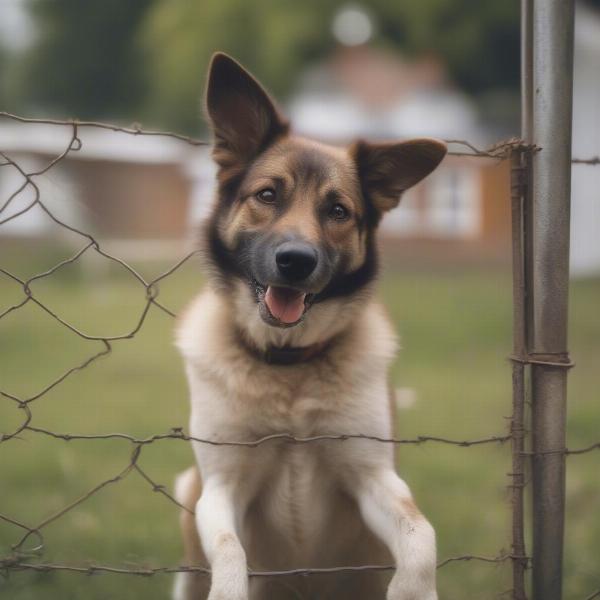The Eastern European Village Dog, often a captivating blend of various breeds, embodies resilience, intelligence, and a unique charm. These dogs, commonly found throughout Eastern Europe, aren’t a recognized breed in the traditional sense, but rather a localized type with shared characteristics. Whether you’re considering welcoming one into your home or simply curious about these fascinating canines, this guide will provide valuable insights into their temperament, care, and the unique considerations that come with owning an Eastern European Village Dog.
Understanding the Eastern European Village Dog
These dogs are typically medium to large-sized, with a sturdy build reflecting their often challenging living conditions. Their coats vary, from short and smooth to thick and double-coated, providing protection against harsh weather. Coloring is also diverse, ranging from solid black or brown to mixes of white, tan, and brindle. While their appearance can be varied, their temperament often exhibits similar traits: intelligence, loyalty, and a protective nature. They’re often naturally wary of strangers, a trait honed by their role as guardians in rural settings.
Temperament and Training
Eastern European Village Dogs are intelligent and capable of learning, but their independent nature requires a patient and consistent approach to training. Positive reinforcement methods work best, focusing on rewards and praise rather than punishment. Early socialization is crucial to ensure they develop into well-adjusted adults. Exposing them to various people, animals, and environments from a young age can help mitigate their natural wariness and prevent fear-based aggression.
Health and Care
Given their hardy nature, Eastern European Village Dogs are generally healthy. However, like all dogs, they are susceptible to certain health issues. Regular veterinary check-ups are essential, including vaccinations and parasite prevention. Their thick coats, especially in double-coated varieties, require regular brushing to prevent matting and manage shedding. Providing a balanced diet and ample exercise is crucial for their overall well-being.
Is an Eastern European Village Dog Right for You?
Bringing any dog into your life is a significant decision. An Eastern European Village Dog can be a loyal and loving companion, but their unique needs require careful consideration. Their protective instincts and potential wariness of strangers mean they thrive in homes with experienced owners who can provide consistent training and socialization.
 Eastern European Village Dog with Family
Eastern European Village Dog with Family
Conclusion
The Eastern European Village Dog, with its distinct blend of resilience, intelligence, and loyalty, offers a unique companionship experience. Understanding their specific needs and providing a nurturing environment will allow these remarkable dogs to flourish and become cherished members of your family. If you are prepared to meet their requirements for training, socialization, and care, an Eastern European Village Dog can be a rewarding and fulfilling addition to your life.
FAQ
- Are Eastern European Village Dogs good with children? While they can be affectionate with family members, their protective nature and size require careful supervision around young children.
- How much exercise do Eastern European Village Dogs need? They are energetic dogs and require a significant amount of daily exercise, including walks, runs, and playtime.
- Are Eastern European Village Dogs easy to train? They are intelligent but can be independent, requiring patient and consistent training using positive reinforcement methods.
- What kind of grooming do Eastern European Village Dogs need? Regular brushing is necessary, especially for double-coated varieties, to prevent matting and manage shedding.
- Where can I find an Eastern European Village Dog? Researching rescue organizations specializing in Eastern European breeds or contacting shelters in Eastern European countries might be helpful.
- Are these dogs prone to any specific health problems? While generally healthy, it’s important to be aware of potential issues like hip dysplasia and certain genetic conditions, making regular vet checkups crucial.
- Do they adapt well to apartment living? Due to their high energy levels and need for space, they are generally better suited to homes with yards where they can roam and exercise.
Suggested Further Reading:
(No relevant articles found on ilmdog.com at this time)
About ILM Dog
ILM Dog is your trusted international resource for expert advice on dog breeds, health, training, nutrition, and care. We’re dedicated to providing practical, reliable information for both new and experienced dog owners worldwide. We cover a wide range of topics, from breed selection and puppy care to senior dog health and travel tips. Whether you’re looking to understand your dog’s behavior, choose the right food, or find the perfect accessories, ILM Dog is here to help. Contact us at [email protected] or +44 20-3965-8624 for personalized guidance and support.